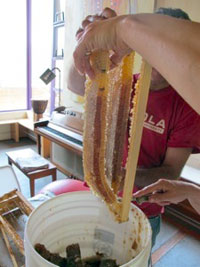 The conditions had to be perfect. We knew there was a ton of honey in the hive. June is the time to harvest, and it was already July. I recently had an unpleasant encounter with the bees when a photographer came to take some pictures of me, my garden, my birds and my bees. (It was late in the afternoon, I was nervous and, was he wearing after-shave? I’m not sure what set the bees off, but they got so feisty. The photographer was stung three times and a persistent bug managed its way into my hood and sent me running and yelping!) So, how to get back to the pleasant calm that husband Martin and I had on our April visit?
The conditions had to be perfect. We knew there was a ton of honey in the hive. June is the time to harvest, and it was already July. I recently had an unpleasant encounter with the bees when a photographer came to take some pictures of me, my garden, my birds and my bees. (It was late in the afternoon, I was nervous and, was he wearing after-shave? I’m not sure what set the bees off, but they got so feisty. The photographer was stung three times and a persistent bug managed its way into my hood and sent me running and yelping!) So, how to get back to the pleasant calm that husband Martin and I had on our April visit?
Advice from fellow beekeeping friend Ilse, who tends bees and chickens at Sky Farm Red was taken: “Visit the bees between 12 and two, be super clean with no scent and freshly laundered bee suits.”
An offer of help from Bee Buddy Bruno was accepted.
So on a recent sunny day, we suited up, sipped our pre-hive-tending-calming beer and went for it.
The bees were out doing their job, so our job was easy. We removed six frames, filled with capped honeycomb. We replaced the frames with empty ones and checked out the box of frames we placed on the hive in April. Honey production was in full force there too, so it looks like we’ll be harvesting another six to eight frames in a few weeks.
 Working inside so that the bees wouldn’t try to get their honey back, we cut the honey comb from the frames into our honey sieve, fashioned from two industrial buckets, one with a portion of the bottom cut out and topped with a strainer (actually a spatter guard).
Working inside so that the bees wouldn’t try to get their honey back, we cut the honey comb from the frames into our honey sieve, fashioned from two industrial buckets, one with a portion of the bottom cut out and topped with a strainer (actually a spatter guard).
The honey and honey comb come in varying shades of amber, based on the age of the honey and the nectar from varying blossoms. We kept the super light and the extra-dark separate, and the difference in taste is remarkable-- the former being so delicate and the latter, robust.
After breaking up the honey comb with a large knife, and okay, an occasional squeeze, the honey slowly dripped out of the wax. After 2 days of dripping, we got about 30 cups of honey. If our next harvest yields as much, you might find a posting on Craigslist: Wild Los Angeles Honey--hand harvested under perfect conditions.
Jeanne Kelley is an established food writer, recipe developer and food stylist based in Los Angeles, California. Integrating locally grown produce with globally influenced flavors, Kelley’s approach to cooking is both simple, festive and fresh. Her recipes can be found in her latest book is Blue Eggs and Yellow Tomatoes: Recipes from a Modern Kitchen Garden and on her blog Eat Fresh.

